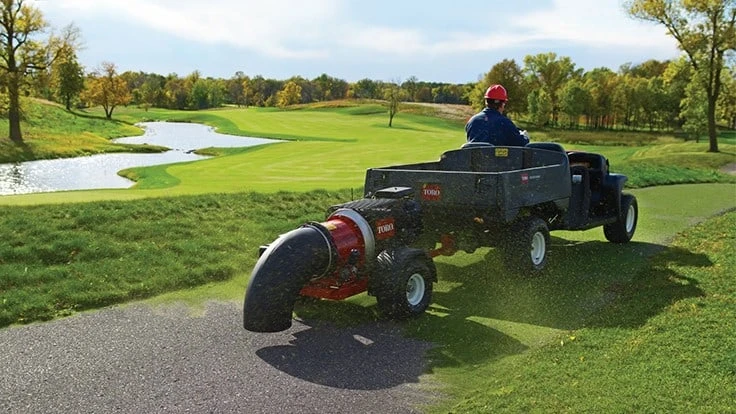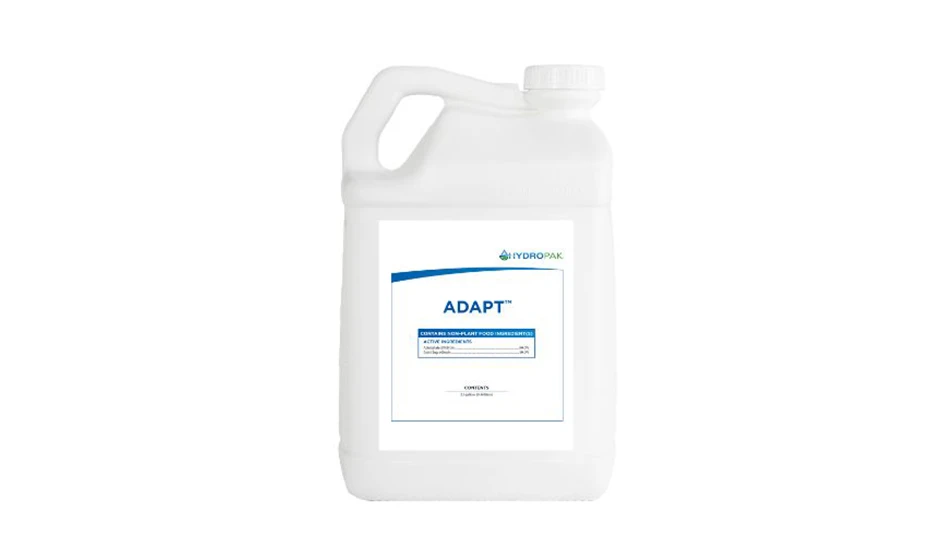
Courtesy of Toro
Whether your course is loaded with leafy maple and oak trees, packed with palm trees, crowded with conifers, or simply stuffed with squirrels, every fall day brings plenty of debris. As fall weather and wind litters the course with leaves, needles, twigs and debris, cleanup is a daily part of your operation. Fortunately, with the right equipment and a two-step approach, you can efficiently and effectively handle fall cleanup.
The cleanup process can be divided into two steps: gathering the debris and removing the debris. You want equipment that can help you do each step quickly to keep the leaves and debris from spreading again and speedily return your course to playable conditions.
Start with a blower
For gathering the debris, you want a blower that can move a lot of material in a short time. Look for a pull-behind blower with a turbine-style fan assembly that delivers a powerful airflow that can move wet, heavy leaves a good distance with each pass. With a full course to clear, moving debris a few inches at a time won’t get the job done. You need both power and airflow.
For maximum efficiency, also make sure the blower’s nozzle can be used directly from the operator’s seat in the utility vehicle and can rotate a full 360 degrees. Keeping the operator seated is essential for safety and also saves significant time. The 360-degree rotation increases efficiency and lets the operator remove debris from any angle on the course. A new nozzle angle indicator easily shows the operator the position of the nozzle and it allows the operator to easily set the nozzle to a low angle that gets air under heavy leaf piles or leaves that may be wet down from dew or rain.
With a powerful blower, you can quickly clear greens and tee boxes, often in a single pass. Clear fairways by working from the center out, adjusting the nozzle so you can make efficient 180-degree turns rather than looping around.
Finish with a vacuum
With the debris gathered by the blower, it’s time to remove it. Again, power and efficiency simplify the job. A pull-behind vacuum or combination sweeper-vacuum with a large hopper is the ideal choice. Power is essential to make sure there’s enough suction to lift leaves and pull up pesky pine needles. A hopper with a capacity of at least 4.5 cubic yards greatly improves productivity by reducing time lost to emptying the machine.
The goal of cleanup is to return the course to playable conditions, so you also want to be sure that your sweeper-vacuum is easy on the turf. Look for a machine with rubber or flexible tips that gently lift debris into the vacuum, protecting the turf while efficiently clearing the debris.
While the one-two punch of a blower followed by a vacuum is the ideal solution for clearing a course, you can also achieve success clearing fairways with just a sweeper-vacuum. With good suction power and a large hopper, you can cover and clear a lot of territory in a short time.
Think beyond fall
It would be nice if fall was the only season that required cleanup, but we all know that isn’t the case. You can increase the return on your equipment investment by choosing equipment you can use year-round. For instance, in addition to clearing grass clippings, leaves, chaff and other debris from fairways, clubhouse grounds, fence lines, cart paths and other paved areas, a powerful debris blower is also ideal for cleaning up aeration cores, divots and bunker sand. You can also use it to clear tee boxes any time of year, blow the dew off greens or to cool greens during a summer heatwave.
Sweeper-vacuum equipment is handy for collecting the cuttings from thicker growth in the spring. It’s also ideal for cleanup following verticutting, scalping, core pulverization and de-thatching.
Think safety, too
Debris gathering and removal can create a lot of dust, so safety features that keep operators from breathing it in are important. Time-saving features, like the ability to control and adjust equipment from the tractor, also increase safety by separating the operator from the activity. Sweeper-vacuums that redirect airflow minimize dust by directing it back to the ground. This increases safety and also reduces the chance that dust will irritate neighbors.
Some sweeper-vacuum equipment include easy-access controls directly behind the tractor for faster, safer dumping of the hopper. Some blowers include a wireless remote control that lets operators start and stop the engine, adjust the throttle, and rotate the nozzle from the safety of the tractor. Models that feature a fully enclosed exhaust system also protect against potential injuries from the heated area around the muffler.
The best fall color is green
The one-two combination of using a blower and a sweeper-vacuum is the most efficient choice for fall cleanup. Golfers will appreciate the clear view of the fairways and greens, and management will appreciate how the productivity increase delivers a higher return on investment.
Steven Peterson is the marketing manager for Toro. This is his first Golf Course Industry contribution.
Latest from Golf Course Industry
- Envu Superintendent Grant Program sending 10 members to 2025 GCSAA show
- Editor’s notebook: Let’s chat about AI
- Wonderful Women of Golf 43: Melissa Gugliotti
- This month on Superintendent Radio Network: December 2024
- Mark Hollinger, ASGCA, dies at 70
- Tartan Talks 102: Chad Goetz
- Don’t fly by the seat of your pants
- Golf Construction Conversations: Reed Anderson





